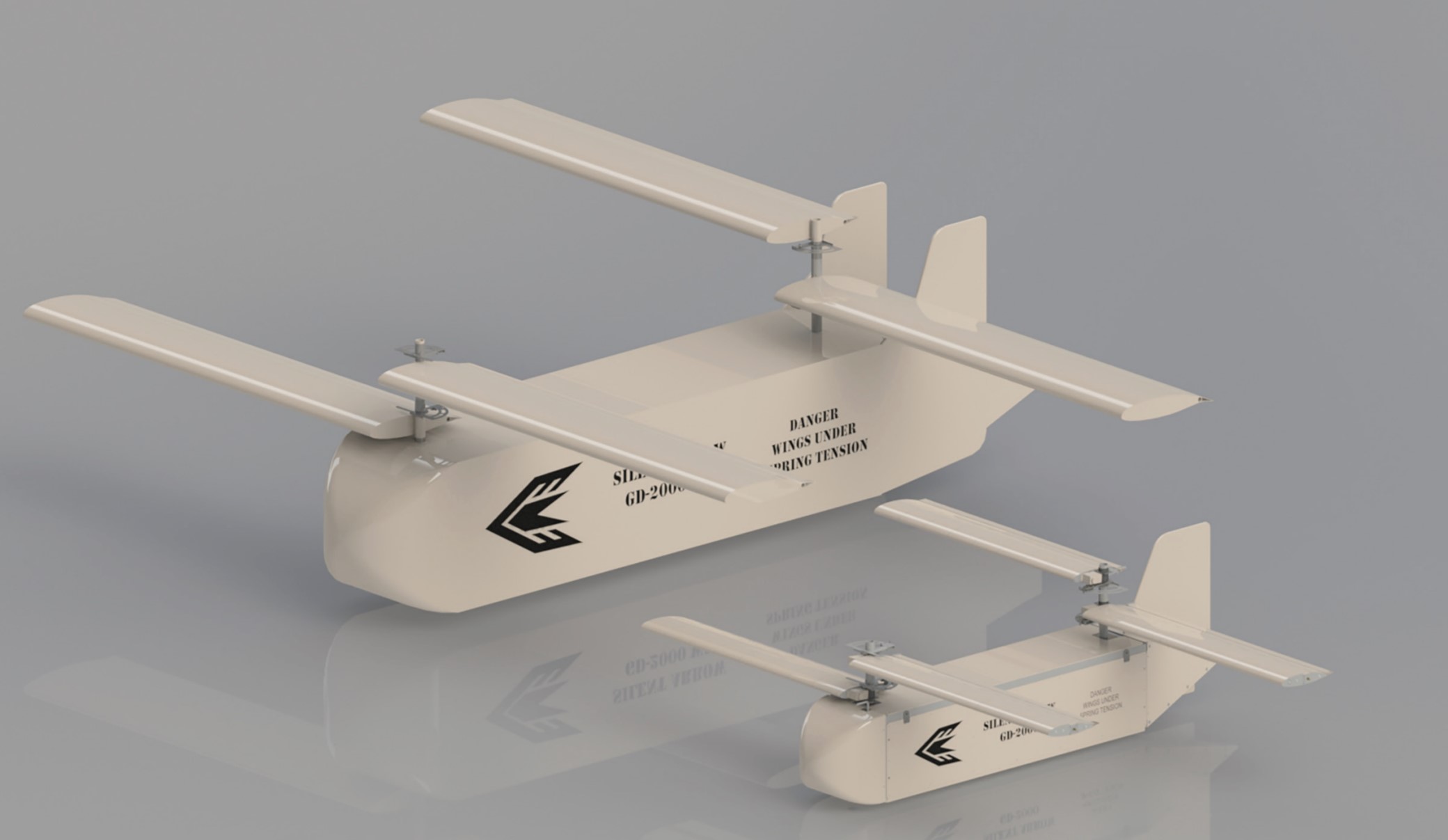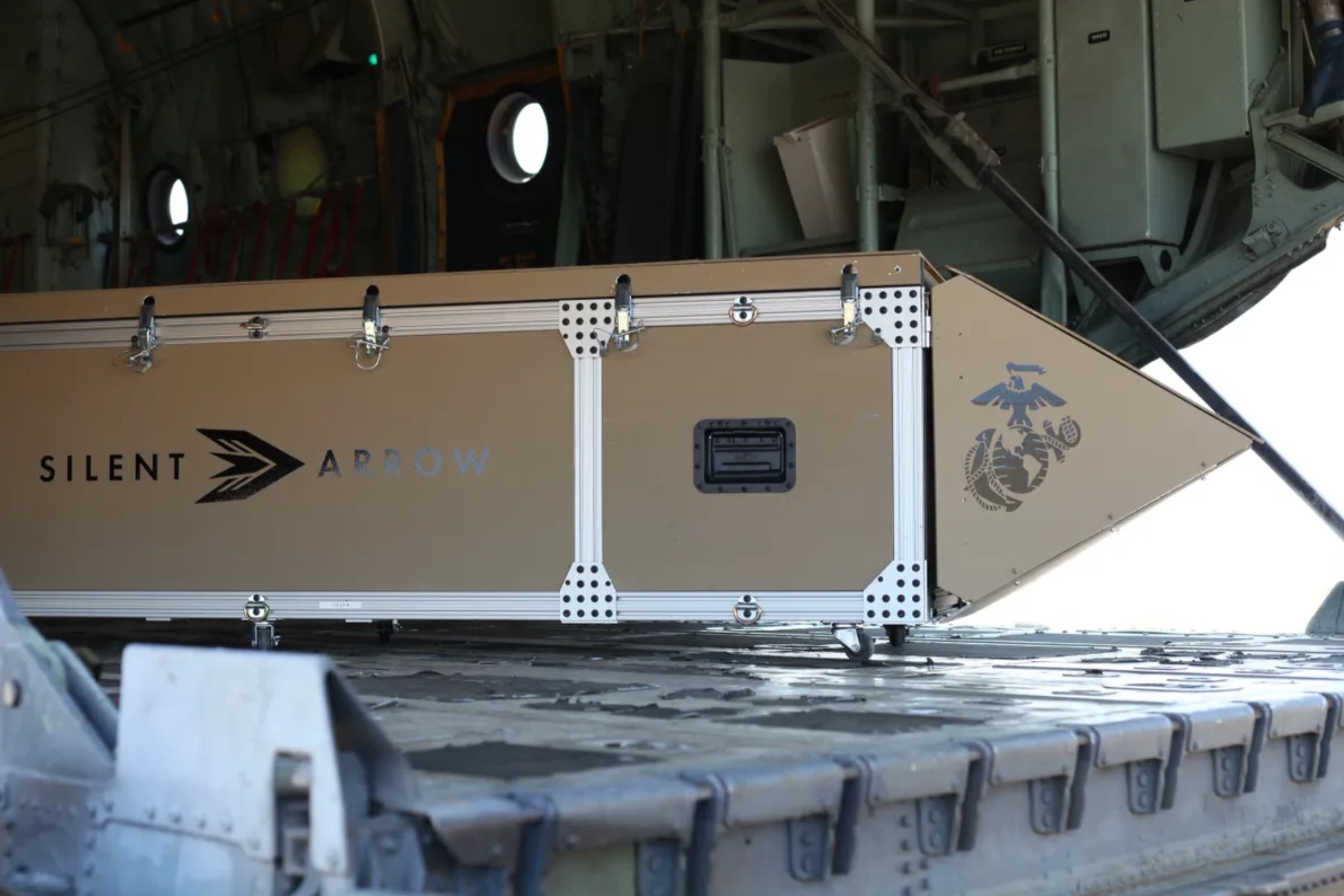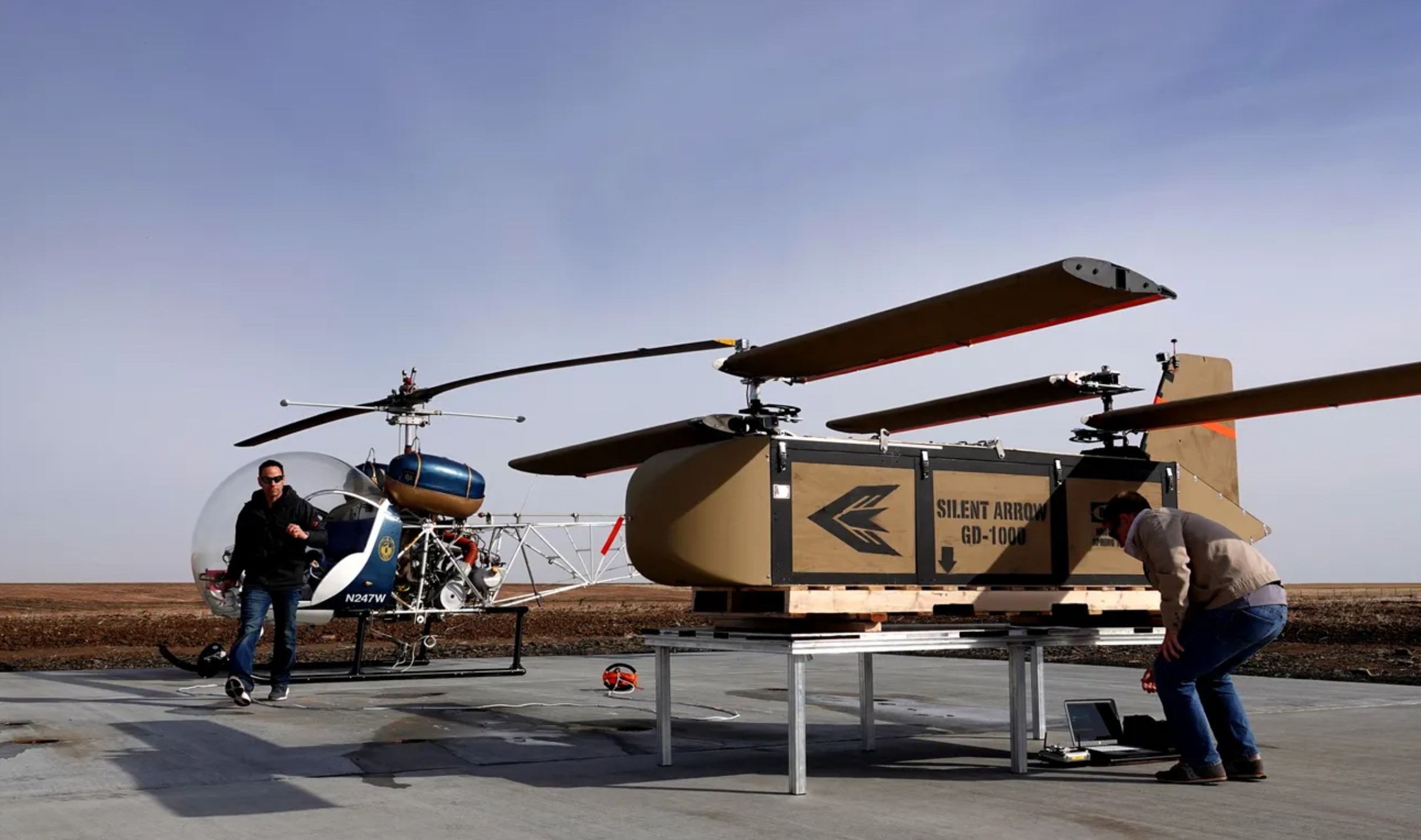Two C-130 cargo aircraft operated by “a U.S.-allied government in the Middle East” have completed successful deliveries using autonomous Silent Arrow GD-2000 cargo gliders in their first overseas deployment. Silent Arrow claims their disposable glider drones can be deployed for military resupply and disaster relief missions at half the cost of existing cargo airdrop systems.
According to a Silent Arrow press release, the successful delivery saw two of the glider drones loaded with 1,026 lbs of undisclosed cargo each, which were then dropped out of the C-130s over “a desert environment.” The GD-2000s then navigated and flew autonomously to their landing point, at which point they executed a flare to reduce their speed and landed successfully. The deliveries were conducted as part of a $1.5M operational evaluation contract, and the company expects to begin full-rate production in 2023 with orders “into the thousands of units.” Currently, 12 of the Block I GD-2000s are deployed to the Middle East, while another 15 are in production.

The GD-2000 is a disposable “standoff delivery platform” which can carry a cargo weight of up to 1,631 pounds and deliver it within 40 nautical miles when dropped from a fixed-wing aircraft at a maximum altitude of 25,000 feet. When dropped from a helicopter, the company claims a 15-mile maximum standoff range.
In their GD-2000 fact sheet, Silent Arrow says the drone can land within 100 meters of its intended target with a full stall landing creating “zero vertical impact.” The sheet also claims that the gliders can fulfill resupply missions at “less than half the cost of JPADS [the U.S. military’s Joint Precision Airdrop System] with more than 2.5X the standoff capability.” Silent Arrow does not list a specific cost-per-unit.

The GD-2000’s rectangular fuselage consists of a 2-foot by 2-foot by 8-foot container with a removable lid that contains the drone’s four 7-foot pop-out wings. Once loaded, the GD-2000’s nose cone and tail are installed on its fuselage and static lines are attached to its host aircraft. When the GD-2000 is pushed out of the aircraft, those static lines remove pins from the closed wings, allowing them to spring open even at airspeeds up to 130 knots. The gliders have a stall speed of 62 knots when half-loaded and 92 knots when fully loaded.
The glider features a variety of avionics that enable it, including a Pixhawk Cube autopilot, magnetometer and barometer, GPS navigation system, LiDAR rangefinder, and optional first-person video and radiofrequency (RF) capabilities. The gliders can be programmed using the Android Tactical Assault Kit, enabling them to be controlled by a variety of off-the-shelf or military mobile devices.
In the fact sheet for the GD-2000, the company states its goal is for each glider to be capable of supplying “1 rifle squad for 1 day of direct-action combat” with standard cargo such as MREs, medicine, ammunition, water, batteries, and fuel.
Silent Arrow also produces a ‘wide body’ variant, the GD-2000 WB, which offers additional internal volume but the same maximum cargo weight and a lower range. Another model, the ER-2000, features a 180-hp electric engine and propeller and can reportedly take off and land on improvised airstrips.

The company says it is currently conducting flight testing with United States Special Operations Command (USSOCOM) C-130s in restricted airspace and is also conducting additional tests “in FAA airspace” with sling loads hung from Bell UH-1H Iroquois helicopters. Silent Arrow lists the C-17, C-130, CH-53, and V-22 as aircraft from which it can currently deploy the GD-2000.
“As we prepare for mass production, it’s encouraging to see foreign allied governments as enthusiastic about the new capabilities Silent Arrow brings to the warfighter as the U.S. military has been,” said Chip Yates, Silent Arrow’s founder and CEO. “We have distribution agreements in place for 37 countries so far and are working hard to become the worldwide standard for airdrop logistics.” The company is also marketing civilian versions of the gliders to be used for humanitarian efforts and disaster relief.

In 2019, USSOCOM signed a development contract with Silent Arrow in order to perform flight testing. In late 2021, the United States Air Force Research Laboratory (AFRL) ordered fifteen GD-2000 gliders from Silent Arrow under a Phase II Small Business Innovation Research (SBIR) contract. AFRL intends to miniaturize the drones further as part of a redesign known as the Silent Arrow Precision Guided Bundle (SA-PGB).
The smaller SA-PBG will measure just 39 inches long and will have a cargo capacity of 350 pounds. It is intended to be capable of swarming operations when launched from aircraft cargo ramps such as in the recent deployments aboard C-130s. In addition, the smaller glider is being eyed for side door deployments, potentially expanding the number of aircraft from which it could be dropped. Silent Arrow’s gliders have already been awarded airworthiness approval by U.S. Air Force Special Operations Command (AFSOC).

Cargo supply gliders that can be deployed from 40 miles away offer unique advantages over traditional resupply airdrop concepts. The gliders could be dropped from just outside denied or contested airspace, keeping manned aircraft out of harm’s way when delivering supplies to forward-deployed units. The standoff range offered by these gliders means that launch vehicles don’t have to get physically near the troops they are resupplying, reducing the chances of potentially making their location or presence known.
Because they have no engines of their own, the gliders would naturally have lower acoustic and infrared signatures compared to powered drones, helping them to potentially glide unnoticed through unfriendly skies to units behind enemy lines or close to air defenses. The ability of the smaller SA-PGB glider to be dropped from the side doors of smaller aircraft could further extend its operational flexibility.

While resupply gliders have been used since at least World War II, the men flying these unsophisticated “flying coffins” saw the highest death rate in the U.S. Army Air Corps throughout the war. The Department of Defense has explored more advanced concepts in recent years involving unmanned systems. In 2017, the U.S. Marine Corps displayed a disposable box-like drone made by Logistic Gliders, Inc. that, much like the Silent Arrow GD-2000, was aimed at resupplying a Marine rifle squad with one day’s worth of supplies.
The U.S. Navy has also tested a variety of autonomous aerial supply drone concepts to reduce its logistical burden. SOCOM has also previously used the CQ-10 Snowgoose, a small UAV featuring a pusher propeller and a parafoil that can carry up to 600 pounds of cargo in its internal bays.

There is a pressing need for resupply and logistics concepts like those offered by the Silent Arrow gliders. Recent conflicts have shown that there is a troubling reliance on logistics chains that are difficult to maintain or protect in theaters of operations far from established military supply lines. Given the Pentagon’s plans to be able to rapidly establish and operate forward bases in austere locations, concepts like Silent Arrow’s autonomous gliders could offer a more cost-effective and safer way to rapidly deliver critical supplies to fill short-term gaps in supply chains during high-tempo operations. The ability to do so during unexpected contingencies without putting aircrew at risk, or at least decreasing that risk, especially in support of special operations and small forward-deployed teams, is especially attractive.
Contact the author: Brett@TheDrive.com
